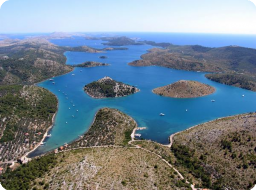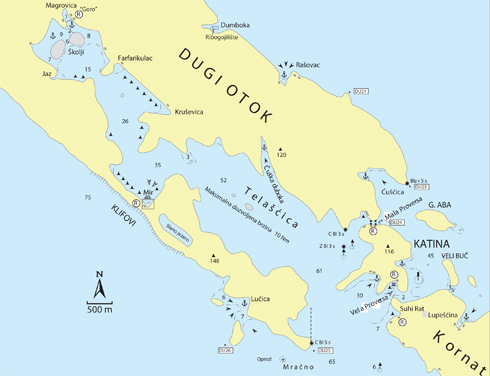

Telašćica Nature Park
Telašćica Nature Park  Map of the bay and rules for sailors
Map of the bay and rules for sailors
Anchorages inside the Park are located in appropriate bays: Magrovica, Podugopolje, Pasjak, Jaz, Kruševica, Mir, Tripuljak, Buhaj and Pod Katina. Buoys for mooring vessels are located in the following bays: Mir, Tripuljak, Krusevica and Kučinmul.
Mooring to buoys is free of charge. It is recommended to moor during the day. The Park management does not assume responsibility for vessels during mooring. The main shipping route from the central channel towards the open sea leads through the Mala Proversa Channel, which is marked with maritime signals (red and green lights).
Zones for water sports and recreation:
Zone 1: Gozdenjak Bay, Mala Kamenišna Bay and Vela Kamenišna Bay
Zone 2: Buhaj Bay, Bok Bay (Pećina) and Strižna Bay
MAP OF THE BAY
 Warning: These maps are for information and not navigation purposes.
Warning: These maps are for information and not navigation purposes.
Source: Karl-H. Beständig "808 LUKA I UVALA - Hrvatska, Slovenija i Crna Gora" (808 HARBOURS AND BAYS - Croatia, Slovenia and Montenegro)
ENTRANCE TICKETS FOR THE TELAŠĆICA NATURE PARK
| ENTRANCE TICKETS |
Warning
- Anchoring is at your own risk.
- The use of speed boats is not allowed near the coast or through the channel.
- The speed limit is 10 knots in Cape Pod Poljica.
- The speed limit is 5 knots at anchorages.
- The maximum depth in the Mala Proversa Channel is 4.3 m.
- The maximum depth in the Vela Proversa Channel is 2.2 m.
- Walking along the trails is at your own risk.
- Do not approach the edge of the rocks.
CAULERPA – THE ENEMY OF LIFE IN THE ADRIATIC
The sea-flowering plant posidonia oceanica, also known as sea grass, is an endemic species of the Mediterranean Sea. It grows from just beneath the surface down to depths of 50 meters on sandy bottoms where it grows in thick submerged meadows. Posidonia meadows are the largest areas of biological diversity in the Adriatic Sea. Many species of fish and crabs live, spawn, feed and find shelter in these meadows, many of which are of important economic importance. In addition, posedonia meadows protect the coastline from erosion with their thick network of roots and rhizomes, which prevent ablation of the sediment from the seabed and also enrich the sea water and sediment with oxygen. Due to various human activities, posidonia meadows are highly endangered and are increasingly disappearing. Besides this species, there are three other species of sea-flowering plants that live in the Adriatic: cymodocea nodosa, zostera noltii and zostera marina.
- The algae caulerpa taxifolia and racemosa also endanger the posidonia meadows.
- These algae are alien species, which means that the Adriatic is not their natural habitat.
- They are invasive species that reproduce, spread and grow over existing autochthonous organisms on the seabed, which leads to their extinction.
- The consequence of the spread of cualerpa is a drastic reduction in the biodiversity of the seabed.
- In the Adriatic, they reproduce asexually when part of the algae breaks off and re-grows.
It is transferred by boat anchors, nets and sea currents.
Posidonia and other sea-flowering plants are highly endangered by the anchoring of yachtsmen. Anchors cut the rhizomes and thus permanently damage the colonies (the rhizome grows at a rate of 1 cm per year).
YACHTSMEN
Please check your anchors. If you find pieces of these algae, remove them before you throw your anchor back into the sea. Do not return pieces of algae into the sea, because new algae will evolve from them. If you find caluerpa, you are obliged to notify the Park Technical or Supervisory Services or the Laboratory for Phytobentos at the Institute of Oceanography and Fisheries in Split of the site on the following telephone number: 021/408-004.
- It is forbidden to throw litter or contaminate in any other way the air, soil or water.
- It is forbidden to destroy, remove or alienate anthropological finds.
- It is not allowed to exploit mineral raw materials, alter the landscape or in any other way exploit the natural resources of the area.
- It is forbidden to pick, collect or remove from their habitat autochthonous plants and fungus.
- It is forbidden to disperse, harass, disturb, catch, hurt or kill protected animal species.
- Recreational fishing is allowed only with a previously acquired permit issued by the Park Supervisory Service. The permit allows fishing with the use of the following equipment: long lines, kančenica, hand-trolls and fishing line with hooks for fishing for squid without the use of a light. The allowed bag is 3 kilos per permit.
- It is forbidden to collect or remove shell fish and other sea organisms.
- It is forbidden to hunt with the use of a spear gun.
- It is allowed to moor boats only at authorised and marked locations. Outside these spots, it is forbidden to moor or anchor boats without special authorisation from the Park management.
- The speed of boats must follow the limits in the Park (from the line that connects Cape Pod Poljica and Cape Gubac towards the back of Telašćica Bay, speeds must not exceed 10 knots, and in the bays where there are larger numbers of boats, such as Mir, Tripuljak, Kruševica, Kučimul, Magrovica, Pod Dugo Polje, Pasjak and Jaz, speeds must not exceed 5 knots).
- Scuba diving is only allowed with a previously acquired permit and at specific locations (Garmenjak Veliki and Mali, Korotan and Podusobine).
- Visitors can move around the Park only in the areas and along the routes that are marked and intended for sightseeing and visiting.
- It is forbidden to light fires.
- It is forbidden to camp out except in places that are designated for this purpose and properly marked.
- Filming or photography for commercial purposes is not allowed without the prior permission of the Park Management.
- Swimming is allowed in the entire area of the park.
- The Park Supervisory Service is directly responsible for protecting the Park and has the authority to issue on-the-spot penalties for violations of the rules laid out in the Telašćica Nature Park Rulebook.
Source: http://www.telascica.hr/
Video
Current news
 Macrocruise charter agency
Additional discount on the boat rental price of betw
Macrocruise charter agency
Additional discount on the boat rental price of betw




























